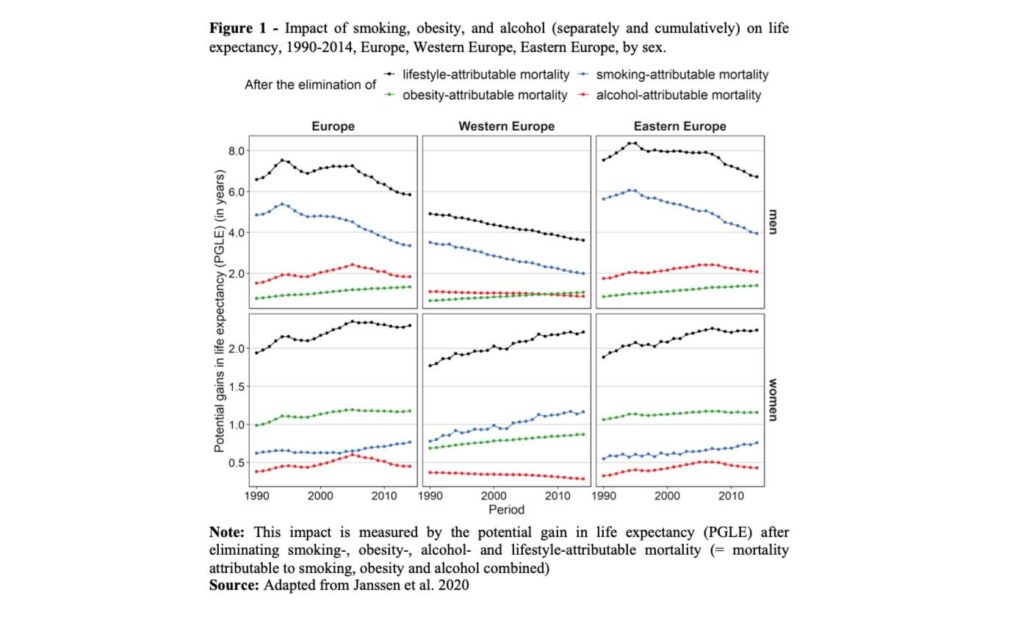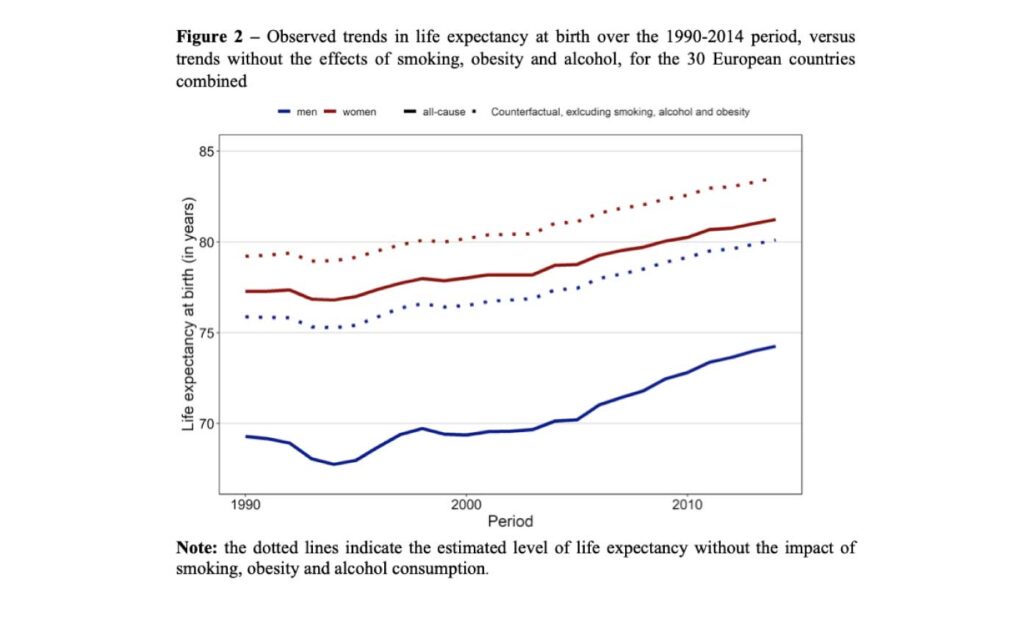Smoking, obesity and alcohol are considered key public health problems in Europe. Fanny Janssen, Sergi Trias-Llimós, and Anton Kunst show how changes over time in these three lifestyle factors have affected secular trends in survival
and estimate that without them, life expectancy in Europe would have been 5.8 years higher among men and 2.3 years higher among women in 2014.
Smoking, alcohol abuse and obesity are considered as key preventable public health problems in Europe. All three lifestyle factors are very common: 29% of European adults smoke tobacco and 23% are obese. In terms of alcohol consumption, the 8 litres of pure alcohol consumed per capita per year are an absolute record in a world where the average is about 6.3 litres. Besides, 60% of Europeans are current drinkers, and 43% of these are “heavy episodic drinkers”, defined as drinkers of 60 or more grams of pure alcohol on at least one occasion at least once per month (World Health Organization, 2019 – Global status report on alcohol and health 2018).
These three lifestyle factors all take a heavy toll on survival. In 2014, across 30 European countries, 24% of all deaths among men were attributable to smoking, and 7% among women, whereas for obesity the share was around 10-11%, and for alcohol 11% among men and 2% among women (Janssen et al. 2020).
The impact of smoking, alcohol and obesity on population health varies considerably across countries, and changes over time. For smoking, we observe a clear wave pattern of increases and subsequent declines in smoking prevalence, followed about 30-40 years later by a similar wave pattern for the share of smoking-related deaths (Lopez et al. 1994). This wave pattern has been observed among men in all European countries (first among north-western European men). Among women, smoking-attributable mortality is still increasing in the majority of European countries (Janssen 2020).
Obesity prevalence has almost tripled in Europe since 1980. Not surprisingly, the share of obesity-related deaths has been on the increase, possibly with very recent signs of a levelling off (Vidra 2019).
For alcohol, the trends are quite diverse across Europe. In eastern and north-western Europe, alcohol prevalence, and hence the share of mortality due to alcohol, have been mostly increasing, albeit with recent stagnation or even decline. In most south-western European countries, on the other hand, these levels have been declining steadily, albeit more slowly in recent years (Trias-Llimós 2019).
Because of the importance of the three lifestyle factors in determining our health status, but also because of their marked temporal changes, we examined their combined effect on life expectancy levels and trends (Janssen et al. 2020). The latter is particularly relevant because of the recently observed stagnations in survival improvements in certain European countries (Murphy et al. 2018).
Combined impact of smoking, obesity and alcohol on national life expectancy levels
The combined impact of smoking, alcohol and obesity on life expectancy at birth (e0) – measured by the potential gain in e0 if these three factors had not existed – was 5.8 years for men and 2.3 years for women in Europe in 2014 (see Figure 1). For men, smoking had the largest impact, for women, obesity.
For men, the impact of the three lifestyle factors on life expectancy levels was much higher in Eastern Europe (6.7 years) than in Western Europe (3.6 years) because of higher prevalence of both smoking and alcohol. For women the slightly higher impact of the three lifestyle factors in Eastern Europe (2.3 years) compared to Western Europe (2.2 years) was driven by a higher impact of alcohol and obesity, partly counterbalanced by a lower impact of smoking.
The (combined) impact of smoking, obesity and alcohol on national life expectancy has not been constant over time (Figure 1). Among men, the increases in obesity- and alcohol-attributable mortality in Eastern Europe were not strong enough to cancel out the overall decline in alcohol-attributable mortality in Western Europe, and – above all – the declines in smoking-attributable mortality. As a result, “lifestyle attributable” mortality across Europe showed an overall decline among men, from 6.6 to 5.8 years.
Among women, conversely, the combined impact of the three lifestyle factors on national life expectancy has increased across Europe, from 1.9 to 2.3 years (Figure 1). This stems from a slight overall increase in mortality attributable to the three lifestyle factors combined, driven primarily by the increase in smoking, but also by increases in obesity and, in Eastern Europe, in alcohol consumption.

Gradual improvement in life expectancy over time, without smoking, obesity and alcohol
As the combined impact of smoking, obesity and alcohol on life expectancy changed over time, the three lifestyle factors combined also affected the improvements over time in life expectancy at birth. Across Europe, the observed increase in e0 over the 1990-2014 period was 5.0 years (from 69.3 to 74.3 years) for men, and 4.0 years (from 77.2 to 81.2 years) for women. Without smoking, obesity and alcohol, the increase would have been 4.2 and 4.3 years, respectively (figure 2).

In short, over the observation period, lifestyle factors have resulted in deviations from this underlying long-term increase in life expectancy, slowing down the progress for women (4.0 instead of 4.3), and accelerating that for men (5.0 instead of 4.2). For men, this improvement has occurred after a period of relative stagnation (in the 1950s, 1960s, and 1970s) due to a strong increase in smoking-attributable mortality (Janssen 2020).
Importance of lifestyle factors for understanding and projecting life expectancy trends
The results showcase the importance of lifestyle factors when studying deviations from the general gradual increase in life expectancy. In Europe – particularly in the United Kingdom, but also in France, Germany, Sweden, and the Netherlands – the rise in life expectancy has been slowing since 2011 (Murphy et al. 2019). Increases in both obesity prevalence and alcohol abuse among adults have been mentioned as potential causes. For women in France, Germany, Sweden, and the Netherlands, the rapid recent increases in smoking-attributable mortality are likely contributors as well.
Similarly, when projecting life expectancy into the future, the impact of lifestyle factors should not be ignored. Because future life expectancy is generally projected by extrapolating past mortality trends (Janssen 2018), they should ideally be based on the more robust long-term mortality trend not influenced by lifestyle factors, and subsequently be combined with estimates of future smoking-, obesity- and alcohol-attributable mortality obtained by applying more advanced projection techniques that take into account the existing (epidemiological) evidence.
Funding
This work is financed by the Netherlands Organisation for Scientific Research (NWO) as part of the research programme “Smoking, alcohol, and obesity, ingredients for improved and robust mortality projections”, grant no. 452-13-001. See: www.futuremortality.com
Bibliography
Janssen, F. (2018). Advances in mortality forecasting: introduction. Genus, 74(21): 1-12.
Janssen, F. (2020). Similarities and differences between sexes and countries in the mortality imprint of the smoking epidemic in 34 low-mortality countries, 1950-2014. Nicotine & Tobacco Research 22: 1210-1220.
Janssen, F., Trias-Llimós, S., and Kunst A.E. (2020). The combined impact of smoking, obesity, and alcohol on life expectancy trends in Europe. International Journal of Epidemiology.
Lopez, A. D., Collishaw N. E., & Piha, T. (1994). A descriptive model of the cigarette epidemic in developed countries. Tobacco Control, 3(3): 242-247.
Murphy, M., Luy, M., Torrisi, O. (2019) Stalling of mortality in the United Kingdom and Europe: an analytical review of the evidence. Working Paper Series London School of Economics – Department of Social Policy. Working Paper 11 – 19.
Trias-Llimós, S. (2019) Alcohol-attributable mortality in Europe: Past trends and their effects on overall mortality variations. PhD thesis. University of Groningen, the Netherlands. ISBN: 978-94-034-1304-4.
Vidra, N. (2019) The obesity epidemic in Europe: Assessing the past and current mortality burden and the future of obesity. PhD thesis. University of Groningen, the Netherlands. ISBN 978-94-6380-306-9.
World Health Organization (2019), Global Health Observatory Data & European Health Information Gateway.


